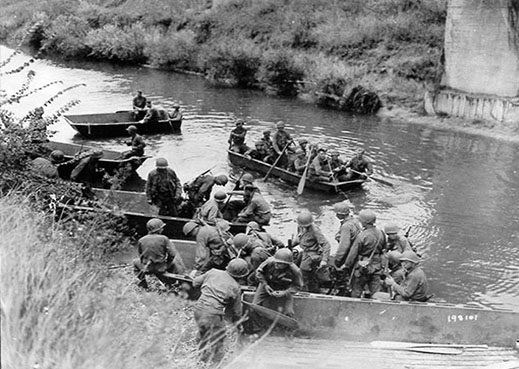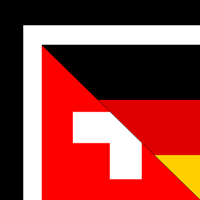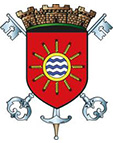
crédit Photo : © NARA US Signal Corps
Choose your language ![]() Wähle deine Sprache
Wähle deine Sprache


Choose your language ![]() Wähle deine Sprache
Wähle deine Sprache

On August 20th, 1944, the treadway bridge (floating bridge) was opened. An M8 armoured car opened the way under the ovations of the inhabitants of Guernes.
After the Normandy landings on June 6th, 1944, and the difficult recapture of the Cotentin, at the cost of many human lives, a wide enveloping manoeuvre brought in a few weeks’ time the army of General Patton on the left bank of the Seine, around Mantes-la-Jolie. The 79th Infantry Division of General Ira Wyche “Cross of Lorraine”- in memory of his commitment on our land during the first world war – managed to cross the river on August 20th, 1944, in Mantes-la-Jolie and in Follainville. Almost three months after the Normandy landings, the 313th and 314th Infantry Regiment installed a bridgehead on the right bank of the Seine.
A key event in the Liberation took place in the southern part of the French Vexin between Vétheuil and Porcheville. The American attack brought a halt to the German troops that had come in reinforcement. v A front formed itself along a line going through different villages: Fontenay-Saint-Père, Sailly, Brueil-en-Vexin. Ten days of relentless attacks and counterattacks followed (from the 19th to the 29th of August 1944).
This “Battle of the Vexin” which almost sank into oblivion, reveals today the precious remnants of a tank battle - the only one in Ile-de-France - between American Sherman tanks bravely fighting the German iron monsters, known to be invincible.
THE ITINIRARY VEXIN 1944 wishes to help you go through the chronology of the events that have durably marked our common memory.

Am 20. August 1944 wird die Pontonbrücke eröffnet. Ein Radpanzerwagen M8 bahnt sich den Weg unter dem Beifall der Einwohner von Guernes.
Nach der Landung an den Stränden der Normandie am 6. Juni 1944 und der schwierigen Rückeroberung der Halbinsel Cotentin, die einen hohen Tribut an Menschenleben forderte, brachte ein groß angelegtes Umfassungsmanöver die Armee von General Patton innerhalb weniger Wochen in Höhe von Mantes-la-Jolie auf das linke Seine-Ufer. Die 79th Infantry Division von General Ira Wyche – in Erinnerung an ihren Einsatz auf französischem Boden im Ersten Weltkrieg auch „Cross of Lorraine Division“ genannt – gelang es am 20. August 1944, den Fluss bei Mantes-la-Jolie und Follainville zu überqueren. Fast drei Monate nach der Landung in der Normandie errichteten das 313. und 314. Infantry Regiment einen Brückenkopf am rechten Seine-Ufer.
Ein entscheidendes Ereignis der Befreiung sollte dann im südlichen Teil des Vexin français zwischen Vétheuil und Porcheville stattfinden. Die amerikanische Offensive kam zunächst angesichts der deutschen Truppen, die als Verstärkung eingetroffen waren, zum Stillstand.
Die so entstandene Frontlinie verlief durch die Dörfer Fontenay-Saint-Père, Sailly, Brueil-en-Vexin und war zehn Tage lang von heftigen Angriffen und Gegenangriffen geprägt (vom 19. bis 29. August 1944). Diese „Schlacht von Vexin“, die fast in Vergessenheit geraten war, offenbart heute wertvolle Überreste einer in der Region Ile-de-France einmaligen Konfrontation von Panzerkampfwagen, bei der sich die amerikanischen Sherman-Panzer mutig den stählernen Ungetümen der deutschen Tiger-Panzer entgegenstellten, die als unbesiegbar galten.
Die MARSCHROUTE VEXIN 1944 bietet Ihnen die Möglichkeit, die Abfolge der Ereignisse nachzuerleben, die einen bleibenden Eindruck im Gedächtnis der Bevölkerung hinterlassen haben.



